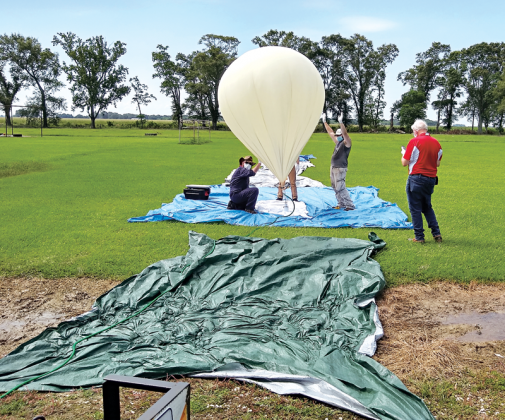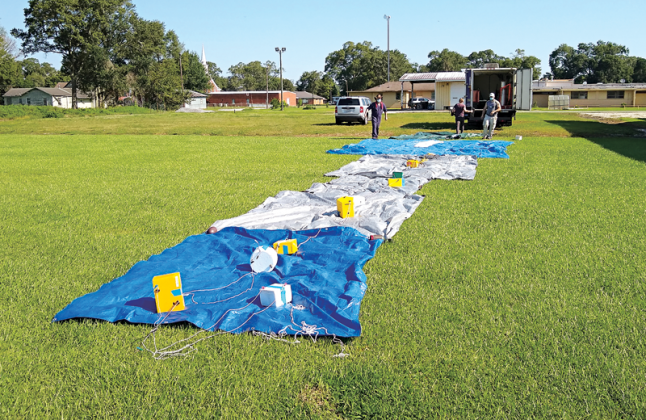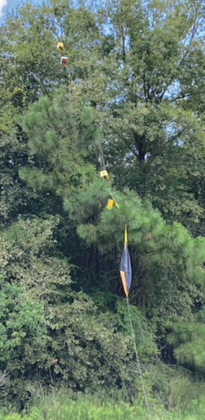


An LSU student balloon launched from Elton High School at 11 a.m. Monday landed at the Eunice Recreation Complex at 1:20 p.m. in a tree behind the Eunice Recreation Complex.
The balloon carried student-developed devices that gathered data during the flight.
Dr. Dana Browne, an LSU faculty and advisor of Louisiana Space Grant Consortium/NASA EPSCoR, Department of Physics & Astronomy, said that the balloon has a tracking radio and GPS device.
The balloon has payload boxes and are laid out before the balloon is attached and inflated.
Browne said, “Each of the small boxes is a payload. These are the payloads laid out before the balloon is attached and inflated. Each is under 1 pound to comply with FAA rules. Three of the boxes house radio beacons to transmit the balloon location during flight. The others contain a small electronic device with sensors powered by a battery.
“The measurements are recorded by a small computer similar to those that run your care, or students use in robotics. The data is stored on a SD card. Each box is made of insulating material to keep the electronics warm.
“Each payload was built by a different team of students at a La. University: Delgado, Loyola, McNeese, NSU, SLU and LSU. All payloads measure temperature inside and outside the box, pressure and humidity.
“Some measured extra things: energy available for convection something that matters in storm prediction (SLU), sky brightness for visible light (McNeese), infrared radiation from the air, important for greenhouse effect (SLU), ultraviolet energy from sun (LSU).”
Dr. Gregory Guzik, professor and director of Louisiana Space Grant Consortium/NASA EPSCoR, Department of Physics and Astronomy, along with his staff advisors Browne, Anthony Ficklin, and LSU grad student Aaron Ryan, Joshua Wolf, and Matt Vicari, both LSU undergrads, performed the sounding balloon launch on the grounds of Elton High School Monday morning.
The initial launching site was picked in Eunice at 11 a.m. Monday at the Eunice Recreational Complex. However, that got changed, with weather and wind conditions, the balloon was launched farther due west. According to Aaron Ryan, an LSU graduate student, said, “We always look at weather conditions, wind conditions, etc.” Ryan says that the balloon is 6 feet in diameter at launch and expands greater as it goes up into air.
The Louisiana State University Department of Physics & Astronomy heads up the Louisiana Aerospace Catalyst Experience for Students (LaACES) Sound Balloon Program from Louisiana Space Grant Consortium (LaSPACE).
LaACES is for students and it is a two semester program that includes the Student Ballooning Course and building a payload.
Students develop science experiments and fly them to 100,000 feet. Students gain practical skills in electronics, Microcontroller programming, project management and writing and communication. It targets entry level students enrolled in Science, Technology, Engineering or Mathematics fields (STEM).
The goal of LaACES is to inspire students to continue towards STEM related courses.
The Student Ballooning Courses (SBC) developed in early 2004 with over 60 flights since 2004.
The LaACES concept is to train students to use acquired knowledge to create a science payload, expose students to skills not normally available in conventional classrooms, and reinforce success by launching each payload upon a latex sounding balloon to 100,000 feet. Students are able to present their analyzed data.
For more information about the program and flight information, go to laspace.lsu.edu/laaces
